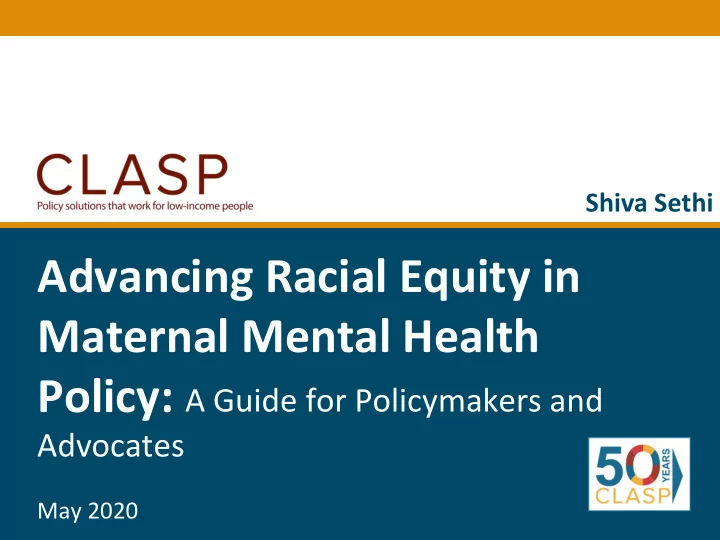

Shiva Sethi Advancing Racial Equity in Title of Presenta.on Maternal Mental Health Conference or Event Title Policy: A Guide for Policymakers and Month Year Advocates May 2020
Goals for this presenta?on Understand barriers to equity in maternal mental health and strategies to overcome them based on successes around the country. CLASP | clasp.org 2 2
Outline • Introduc?on to CLASP and our Maternal Depression work • Defini?ons of Key Terms, Overview of Inequi?es in Maternal Mental Health Care • Common Barriers to Advancing Equity • Strategies to Overcome these Barriers & Examples of Success • Addi?onal Resources CLASP | clasp.org 3 3
The Center for Law and Social Policy CLASP | clasp.org 4 4
CLASP’s Mental Health Work CLASP’s mental health work is focused on maternal depression (and other perinatal mood and anxiety disorders) as well as young adult mental health for people with low incomes aged 16-25. CLASP | clasp.org 5 5
The Moving on Maternal Depression (MOMD) Project • CLASP began the MOMD project to increase access to screening, preven?on, and treatment services for maternal depression while advoca?ng for services that are racially equitable and culturally relevant. • We have been working closely with NJ, NY and PA as well as 7 other states through a learning community. CLASP | clasp.org 6 6
CLASP | clasp.org 7 7
CLASP’s Defini?on of Racial Equity • Our defini?on of racial equity is the condi?on that would be achieved if your racial iden?ty no longer predicted your life’s outcomes. CLASP | clasp.org 8 8
Social Determinants of Health CLASP | clasp.org 9 9
Why We Need to Fight Inequity in Maternal Health Simply – the status quo isn’t equitable. • Nearly 40 percent of mothers of color experience depression ader giving birth, twice the overall rate. • Black women experience the highest rate of pre-term birth na?onwide. • Na?ve American mothers are twice as likely to die during or ader childbirth than white mothers, Black mothers are 3 ?mes as likely. CLASP | clasp.org 10 10
Common Barriers • The high cost of care • A lack of service providers • Cultural beliefs about mental health treatment including a lack of trust in the health care system • Lack cultural competency in the mental health system • S?gma about mental health both among and about communi?es of color • Language barriers • Racism, bias, and discrimina?on in treatment seengs • Lack of transporta?on, child care, paid leave, or ?me off from work CLASP | clasp.org 11 11
Strategies to Overcome these Barriers • Disaggrega?ng data • Using upstream approaches • Building long term, respecgul rela?onships with the people you serve • Hiring and retaining staff that reflect the diversity of their communi?es • Regularly assess how policies impact different communi?es CLASP | clasp.org 12 12
Disaggrega?ng Data Allegheny County, PA created an integrated, cross-agency data inventory to examine racial inequi?es. CLASP | clasp.org 13 13
U?lizing Upstream Approaches The Resilient Boston Project used the city’s history of racial division and social determinants of health to understand to guide its approach to reducing trauma and inequity in the city today CLASP | clasp.org 14 14
Building Trus?ng Rela?onships Minnesota’s Department of Health has partnered with the Somali American Parent Associa?on to improve their mental health services for that community. CLASP | clasp.org 15 15
Building a Diverse & Culturally Competent Workforce The New York City Department of Health and Mental Hygiene conducted department-wide racial equity trainings and assessments. CLASP | clasp.org 16 16
Conduc?ng Regular Equity Assessments San Mateo County, California conducted a 10 year review of a variety of health equity ini?a?ves. CLASP | clasp.org 17 17
The Impact of Centering Equity • Throughout the MOMD projects we have made racial equity a key focus of our work. • As a result, Pennsylvania revaluated its goals to focus more inten?onally on closing dispari?es, figh?ng racism and implicit bias. • In New York, our focus on equity has brought in groups of mothers with lived experience to the policymaking table. CLASP | clasp.org 18 18
Addi?onal Resources • The report contains many more resources for more informa?on. • Many organiza?ons like the Center for Social Inclusion and RaceForward offer racial equity related trainings that may be useful CLASP | clasp.org 19 19
Specific recommenda?ons for advocates • Many of these strategies can be adapted for internal as well as external work. Start with internal reform! • Hold yourselves and your partners accountable for centering equity throughout your work. CLASP | clasp.org 20 20
Coronavirus, Maternal Mental Health & Equity • Many of us know that the coronavirus has had a greater impact on many communi?es of color than it has had on the rest of the country. Black, La?nx, and Na?ve communi?es have been hit especially hard. • The COVID-19 pandemic and the economic and mental health crises that it has caused make equity more important than ever. CLASP | clasp.org 21 21
Ques?ons? You can contact me at ssethi@clasp.org CLASP | clasp.org 22 22
Moderated Shiva Kay by: Joy Sethi Matthews Burkhard CLASP | clasp.org 23 23
Recommend
More recommend